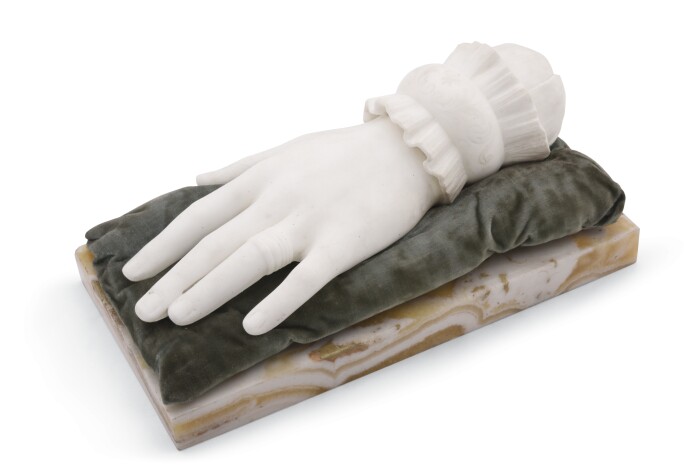T he House of Habsburg, also known as the House of Austria, was for centuries one of the most influential families in the world, with a reign that spanned over 600 years. Reigning over the Austro-Hungarian Empire until 1918, the Habsburgs also occupied the throne of the Holy Roman Empire and through dynastic marriages, intermarriages, alliances and conquests, their territories extended to Austria, Bohemia and beyond.
This illustrious ancestry is demonstrated by the opulence of the 72 pieces offered in Sotheby's upcoming sale Royal & Noble, which gives us a chance to focus on property formerly from the descendants of Leopold II, Holy Roman Emperor (1747–1792) and his wife Maria Louisa of Spain.
Their youngest son was Rudolph of Austria (1788–1831), an Austrian clergyman and noble, consecrated Archbishop of Olomouc in 1819. In 1803-1804, Rudolph began taking lessons in piano and composition from Ludwig van Beethoven, of whom he became a patron and the dedicatory of many works. He was also an accomplished amateur painter and three pastel paintings in this sale are rare examples of his work, probably meant to be kept in the privacy of the Imperial Family and gifted to his brother, Archduke Rainer Joseph of Austria, Vice King of Lombardo-Venice (1783–1853).
King Charles I of England (1600-1649) and by descent Archduke Rainer Joseph of Austria, who married Princess Elisabeth of Savoy (1800-1856) in 1820, owned these two paintings, capturing religious scenes previously painted by Rubens, Bruegel the Elder, and Tintoretto. The first depicts a scene from the New Testament, the Massacre of the Innocents, in which Herod the Great, King of Judea, orders the execution of all male children of two years old and under, in the vicinity of Bethlehem. The second painting describes the biblical account of Christ miraculously feeding five thousand of his followers with just five loaves and two fishes.
Among Rainer’s and Elisabeth’s eight children were Archduke Heinrich Anton of Austria (1828–1891) and Adelaide, said to be his favorite daughter, who became Queen of Sardinia (1822–1855), wife of Victor Emmanuel II of Sardinia, later King of Italy.
When Archduke Heinrich Anton of Austria married the singer Leopoldine Hofmann (1842–1891) on February 4th 1868, he lost his title. In 1871, Emperor Franz Joseph, by surprise, re-affirmed his son's membership to the family. The couple settled in Bolzano in North Italy and had a daughter one year later, Countess Rainiera von Waideck (1872–1936) who later married Count Enrico Lucchesi Palli, 11th Principe di Campofranco (1861–1924) in 1892
Count Enrico Lucchesi Palli together with his cousin Enrico, Prince of Bourbon-Parma, Count of Bardi, and other notable relatives embarked on a journey around the world between 1887 and 1891, which also took them to the Middle and Far East.
For a family that ruled over a large Empire, travelling was not unusual. From these voyages, they brought back items for their collection. Highly decorative belt buckles such as this one, designed with filigree motifs and sometimes enriched with enamel and semi-precious stones, formed part of the fashionable Ottoman woman's costume in the eighteenth/nineteenth century.
They most likely always travelled in style. The sets of silver mounted gala coach harnesses and other riding equipment demonstrate how the European upper classes defined their high status by the elegance and beauty of the objects that they owned, and this tradition could well extend to their horses.
The lots to be offered in January also bear witness to the family’s connections with the House of Bourbon-Parma, one of the most influential royal dynasties of Europe. For instance, Count Enrico Lucchesi Palli’s grandfather, married Marie-Caroline of Bourbon-Two Sicilies, widow of the Duke of Berry (1798-1870), and therefore, Enrico had Princess Louise Elisabeth of Bourbon-Berry, Prince Louis de Bourbon-Berry, Louise Marie Thérèse d'Artois, Duchess of Parma and Henri d'Artois, Duke of Bordeaux and Count of Chambord as aunts and uncles.
Art collecting in the House of Habsburg was a tradition and all the lots in Royal & Noble were passed on from one generation to the next, which strived to build on the collection of their predecessors. In January, catch this exceptional chance to discover a collection reflecting the taste and opulence of one of the most powerful Imperial families.
CLICK HERE to see the video for this sale, and HERE to see the highlights slideshow.










